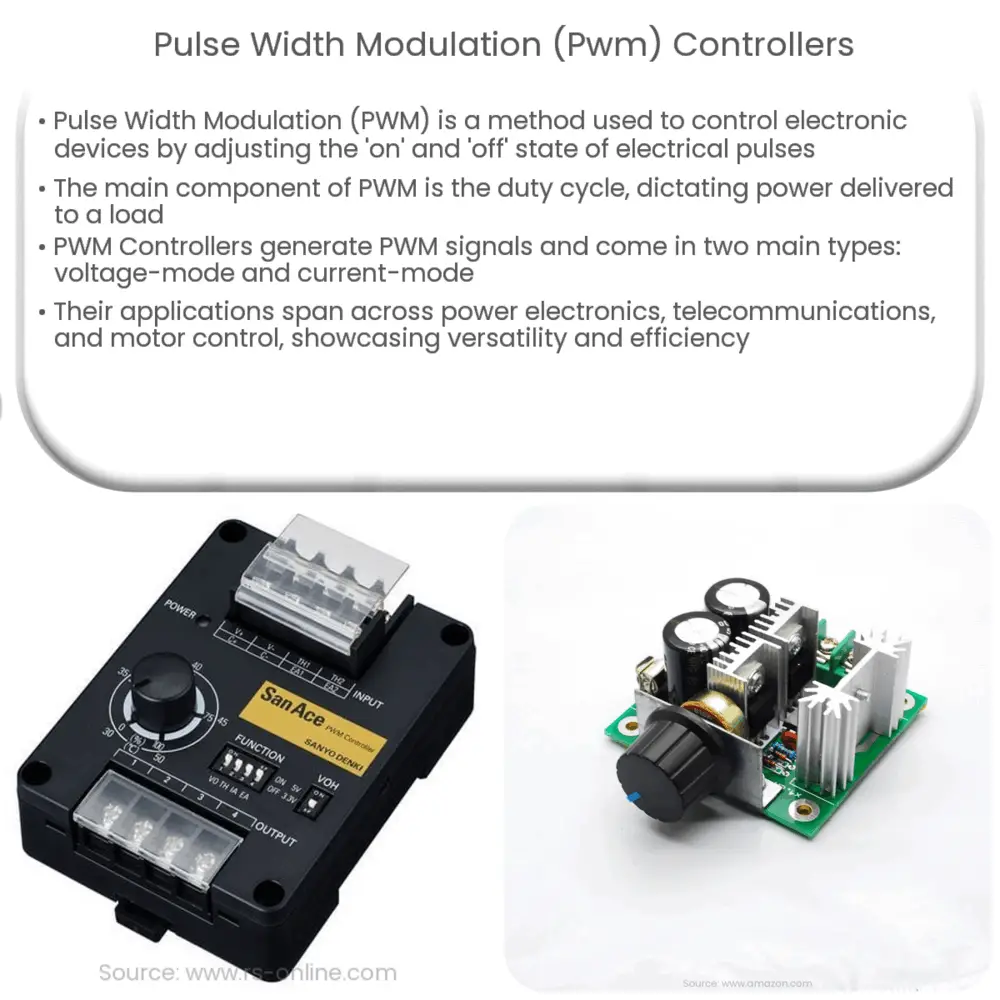Explore the world of Pulse Width Modulation (PWM) Controllers, their workings, applications, and benefits in electronics.

Introduction to Pulse Width Modulation (PWM) Controllers
Pulse Width Modulation, commonly referred to as PWM, is a powerful technique used primarily in controlling electronic devices. It functions by altering the ‘on’ and ‘off’ state of an electrical pulse to control the amount of energy supplied to an electrical device. This article will delve into the intricacies of PWM and its controllers, their functions, and their applications.
Understanding Pulse Width Modulation
PWM is a technique where the width of the digital signal’s pulse is modulated, hence the name ‘Pulse Width Modulation’. This technique generates variable-width pulses to represent the amplitude of an analog input signal. The key factor in PWM is the duty cycle, the proportion of ‘on’ time to the regular interval or ‘period’ of time. A change in duty cycle alters the amount of energy provided to a load, enabling precise control of the power delivered.
PWM Controllers
A PWM Controller is a device that generates a PWM signal. It takes an input control signal and produces a PWM signal with a corresponding duty cycle. The key components of a PWM controller include the oscillator, error amplifier, comparator, and output driver. The main types of PWM controllers are voltage-mode and current-mode controllers.
- Voltage-mode controllers: In this type of controller, the output voltage is fed back and compared with a reference voltage. The error signal is then used to adjust the duty cycle of the PWM signal.
- Current-mode controllers: These controllers use the inductor current instead of output voltage to control the duty cycle. They provide faster response and better loop stability than voltage-mode controllers.
The PWM controller’s versatility makes it widely applicable in various industries and technologies, such as power electronics, telecommunications, and motor control.
Working of PWM Controllers
The PWM controller works by continuously adjusting the duty cycle to maintain the desired output. The oscillator generates a sawtooth waveform, which is compared to the error signal from the error amplifier. The comparator produces a PWM signal based on this comparison, and the output driver amplifies this signal to drive the load.
The intricate workings of PWM controllers underscore the elegance and precision of modern electronic control systems. In the following sections, we will delve deeper into the applications and benefits of PWM controllers.
Applications of PWM Controllers
PWM controllers find a vast array of applications in various fields.
- Power Supply: PWM controllers are a crucial component in switch mode power supplies (SMPS). They help control the output voltage or current precisely.
- Motor Control: In motor speed control, PWM allows for efficient control of motors by providing varying levels of electrical power.
- LED Dimming: In LED technology, PWM controllers adjust the perceived brightness by rapidly switching the LED on and off at different rates.
- Audio Applications: In Class D amplifiers, PWM is used to convert the audio signal into a series of pulses before it is sent to the speaker.
- Telecommunication: In telecommunication systems, PWM is used in direct sequence spread spectrum (DSSS) to generate the spreading code.
Benefits of PWM Controllers
PWM controllers offer numerous benefits, including:
- Efficiency: PWM signals are inherently power-efficient. They help reduce the power loss in switching devices.
- Flexibility: The PWM duty cycle can be altered with considerable flexibility, making it suitable for a wide range of applications.
- Stability: PWM signals are highly resistant to noise, which contributes to signal stability.
Conclusion
In conclusion, Pulse Width Modulation (PWM) Controllers play a pivotal role in the realm of electronics and electrical engineering. By controlling the ‘on’ and ‘off’ state of an electrical pulse, they afford precise control over power delivery, providing a versatile and efficient solution for a wide array of applications. From motor control and power supply to LED dimming and audio applications, PWM controllers underpin the functionality of many systems integral to our daily lives. As technology continues to evolve and demand for energy-efficient solutions increases, the significance of PWM controllers is set to grow even further.

